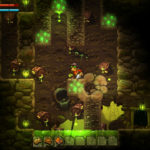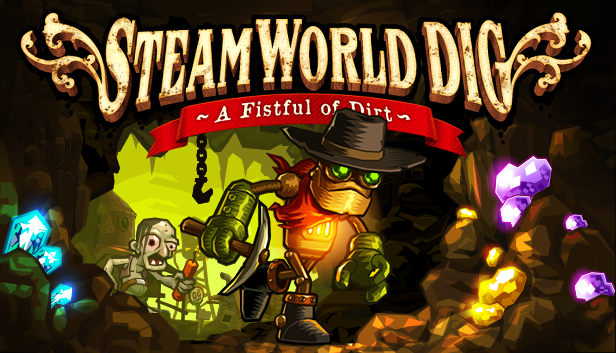I recently bought the Humble Bundle 12 in order to get a copy of Gone Home and Papers, Please. I really wanted to try both of those games. After playing Papers, Please, I decided to play a different game from the bundle and tried out SteamWorld Dig. As a result, I found my favorite game of that bundle so far. It doesn’t often happen that the game I bought a bundle for is not my favorite, but when it does, I am pleasantly surprised.
SteamWorld Dig is a clever platformer staring a steam powered robot named Rusty. Developed by Image and Form, SteamWorld Dig takes you to the heart of a mining town built on top of a mine with many dark secrets about the past and source of the robots that make up the cast.
The game opens up as Rusty travels to the mining town to visit his Uncle Joe just to find out that his Uncle is dead, beyond repair. Inheriting his trusty pickax, Rusty must dig through his Uncle’s claim to find out what happened to him. Throughout exploring the mine, Rusty finds ore and minerals that allow him to purchase new equipment and upgrades. Additionally, Rusty stumbles upon mysterious platforms that provide him new powers and abilities that allow him to reach harder to explore areas. Eventually, these new powers allow Rusty to solve the mystery of his Uncle’s death.
SteamWorld Dig is billed as a Metroidvania style game and its inspiration from these roots is pretty clear. However, the roots of this genre are not deep seated in the game. While gaining new powers allows you to explore more, the rewards for revisiting previously explored areas are lacking the impact that the genre’s parent games had. Instead, most of the rewards are to be found by continuing to dig deeper into the mine.
 The gameplay for the game is quite rewarding at first, but eventually reaches a bit of a repetitive spell. For instance, the purpose for mining ore and minerals is to raise money to buy upgrades to your equipment, and those upgrades are design almost exclusively to provide you the ability to mine more ore. It would have been much nicer to have a wider variety of tasks to perform with the equipment found.
The gameplay for the game is quite rewarding at first, but eventually reaches a bit of a repetitive spell. For instance, the purpose for mining ore and minerals is to raise money to buy upgrades to your equipment, and those upgrades are design almost exclusively to provide you the ability to mine more ore. It would have been much nicer to have a wider variety of tasks to perform with the equipment found.
Where SteamWorld Dig really shines, though, is in the art and world building. The world building is done, not in dialog or narrations, but in the art of each of the three main areas. Each area tells a different story through the traps, monsters and back drops. One of the most interesting finds I had while exploring this world was finding a run down video game store in one of the game’s secret rooms.
Finally, the overall game is short but fulfilling. Image and Form has built in the right amount of content to fit the amount of time needed to complete the game. I was able to finish the game in about 5 hours and explored the whole mine, getting all ore and minerals, in about 7 hours. However, I can’t find a lot of replay value in the game outside the procedurally generated mine for each playthrough. If you are the type of person that likes to just dig around and see what you can find, you will likely find some fun in replaying the game. However, the lack of any new surprises to be had in a repeat playthrough dings the game a bit.
In the end, SteamWorld Dig is a great introduction to an amazing looking world that Image and Form is planning to expand upon in their next game SteamWorld Heist. Based on the teaser trailer for that game, they are keeping to the visual style and world building they perfected with Dig. Overall, I would highly recommend giving this game a try. For $10 on Steam or the Humble Store, you really can’t go wrong.
To learn more about SteamWorld heist and other world by Image and Form follow them on Twitter or check out their blog.






